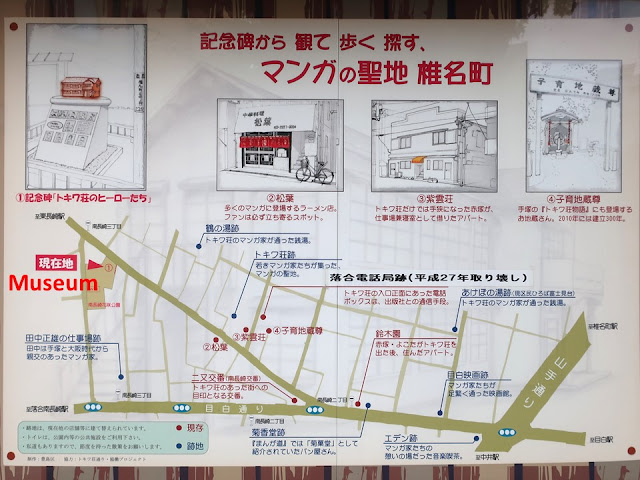Tokiwaso was a legendary apartment in
Tokyo. Gifted manga artists such as Fujiko.F.Fujio who created “Doraemon” lived
together in the early 1950s. The apartment was
rebuilt and was opened to the public in 2020 as a museum. We can know their
lifestyle, and we can feel their passion in the building and in the town.
トキワ荘は、鉄腕アトムの手塚治虫、天才バカボンの赤塚不二夫、ドラえもんの藤子・F・不二雄など、昭和34年生まれの私を育ててくれたような漫画家が同時期に住んだ伝説のアパートでした。2020年に、建物だけでなく、その生活までも復元した博物館がオープンしました。
彼らのエネルギーを感じられる博物館、そして街でした。
The sign on the road leads us to the museum.
路上の案内表示がバッチリ。どんな街に住んでいたのか、気分があがります。
Through the alley, there is a street where Tokiwaso is. It's just one station from Ikebukuro which is a popular downtown.
路地を抜けて進むとトキワ荘がある南長崎花咲公園。
The map near the museum shows related places to Tokiwaso.
トキワ荘界隈の案内板
Tokiwaso was built in 1952. Tezuka Osamu who was the pioneer of Japanese modern manga (his official site in English: https://tezukaosamu.net/en/) moved there in 1953, thereafter manga artists moved there one by one.
トキワ荘は、1952年にオープン、1953年に手塚治虫が入居してから漫画家が住み始めました。手塚治虫は翌年、引っ越しますが、その部屋に藤子不二雄Aが入居しました。
I entered into the entrance and went up to the second floor.
玄関を入り、階段を上がります。
The restroom is up the stairs; it is for men and women and is not a flush toilet.
上がると便所があります。男女共用でくみ取り式。
There is a common kitchen and a dining room next to the restroom. They washed their faces and clothes at the sink, too.
便所の隣は共同の炊事場。流しは、洗面所&洗濯場所だったそうです。
There is a ramen bowl on the table. It is similar to the apartment I lived while I was a student.
テーブルの上には、松葉のラーメン鉢が。私が住んでいた下宿に限りなく近い。
Nine rooms are located on both sides of the corridor. Geniuses of manga lived.
中央の廊下を挟んで四畳半が9室あります。天才たちが住んでいました。
Layout and residents of the second floor.
2階のレイアウト(パンフレットから)
The Room 20 is full of tools to draw manga. He needed patience for sitting on the tatami mat floor and drawing, I reckon.
20号室:よこたとくおの部屋は漫画を書く道具で一杯です。座卓で執筆は大変だったと思います。
There are also a component stereo system, vinyl records and books.
壁際には、シャツとステレオ、将棋盤、レコード。本も沢山あります。
We can take photos while fascinating ourselves a manga artist. However, it was prohibited because of the coronavirus pandemic when I visited.
石ノ森章太郎の17号室と、赤塚不二雄さんの16号室は、漫画家気分で写真撮影や漫画を書ける部屋ですが、コロナ対策でセットはありませんでした。残念。
A female artist (Mizuno Hideko) lived in the Room 19. She is a pioneer of girls manga. She came here with the trunk and collaborated with the manga artists. However, she lived here for only seven months. I may understand why.
19号室の水野英子さんは少女漫画の先駆けです。柳行李一つで上京し、石ノ森章太郎、赤塚不二夫との合作に取り組んだそうです。住んでいたのは7ヶ月間。なんとなく、分かるような気がします。
Fujiko.F.Fujio lived in the Room 15. He was respected by Fujiko.Fujio.A because he always drew Doraemon with a boy's heart. They mentioned there were implacable friends; they inspired one another.
15号室は、藤子・F・不二雄が住んでいました。漫画家の暮らしがパネルで紹介されています。トキワ荘で生活を共にした、藤子・不二雄・Aさんは、少年の心でドラえもんを書き続けたF・不二雄さんを敬愛していました。最後の絵コンテに「四畳半・・・、いつも近くに仲間がいた・・・」と書き残しています(2022.4.12:NHKクローズアップ現代)。刺激が才能を育てるのですね。
It is written, “They reduced the expenses for food and clothes, but they didn’t hesitate to spend money for entertainment expense and cultural-amusement expenses (films, books).” For example, someone watched twenty movies a month on average, the other purchased expensive items such as an 8mm movie camera, a stereo component and vinyl records.
It says, “They devoted entire lives to draw
manga. --- amusements were nutrient sources of their creative activities.” So
passionate!
食費と洋服代を節約して、仲間との交際費や、映画、書籍などの教養・娯楽費は惜しまなかった、と書かれています。池袋や新宿で月平均20本の映画を見たり、高額な8ミリカメラやステレオ、レコードを購入しました。
「彼らにとってマンガを描くことが生活のすべてであり、(中略)娯楽は、すべて創作活動の“栄養源”だったのです」と書かれていました。熱いです。
The photo above shows actual apartments. It shouldn’t be so old when they lived; it may be more like the museum.
実物の写真。天才たちが住んでいた頃は、築10年に満たなかったので、今のミュージアムの写真の方が近かったと思います。(パンフレットから)
Walking around Shiina-cho、椎名町散策
The ramen shop “Matsuba” is popular even until now.
ラーメンの松葉は、今も人気です。
Manga of Fujiko.Fujio.A is put up on the door.
扉には、藤子不二雄Aのマンガが貼ってあります。
“Tokiwaso-toori(street) Oyasumidokoro (rest station)” looks like a museum shop.
「トキワ荘通りお休み処」はミュージアムショップです。http://www.toshima-mirai.jp/tokiwaso/
(in Japanese)
Visited in September, 2020
Official website: https://tokiwasomm.jp/en/
https://tokiwasomm.jp/
(in Japanese), accessed in February, 2023
Previous post (museum in a 130 year-old warehouse in northern Japan): Shounai-rice
museum in Sankyo warehouse、庄内米歴史資料館と山居倉庫
Next post (tiny museum in Tokyo): Acupuncture, moxibustion and massage museum in Ryogoku sumo wrestling district、鍼灸あん摩博物館と両国国技館


























Comments
Post a Comment